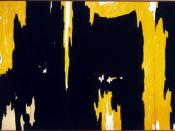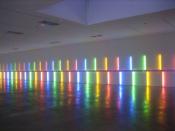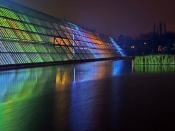To Be Enlightened, You Pull the Switch
In Washington, pilots now passing over this city at night have been reporting a weird green light emanating from the East Building of the National Gallery. That would be the art of Dan Flavin, the American avatar of the fluorescent tube.
The light comes from "Untitled (To You, Heiner, With Admiration and Affection)," a low, fencelike barrier, 110 feet long, spanning one side of the atrium's broad mezzanine. Typically about as suited to exhibiting art as an airport terminal, the space has now been gaudily transfigured by this catchy introduction to Flavin's traveling retrospective -- the first retrospective of his art, believe it or not, since the late 1960's. Lacking some of the spectacular site-specific, architectural works he did later in his career, the show, which opens on Sunday, is nevertheless a qualified beauty, and the latest sign of Minimalism's reconsideration.
Flavin was one of the movement's founding figures, an artist who had a good idea.
It sufficed to keep him going until he died in 1996, at 63. In a sense it even sustained him afterward, through the works he planned that others completed for him posthumously, like an installation for a church in Milan and another for a suite of defunct Army barracks in Marfa, Tex.
Flavin's idea was to make art out of off-the-rack industrial light fixtures. A few sizes. A handful of colors. Just follow his instructions. It seemed, as an approach, utterly impersonal and possibly not even art as people then knew it. But like so many other radical artistic reactions against Abstract Expressionism's stress on touch and raw emotion, it was the unlikely route to often ecstatic utterance. It consciously blurred the distinction between art and architecture, seizing architecture as part of art's sculptural vocabulary, incorporating...


